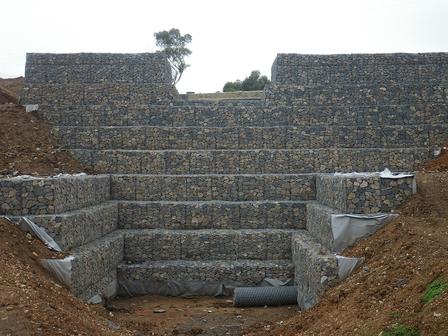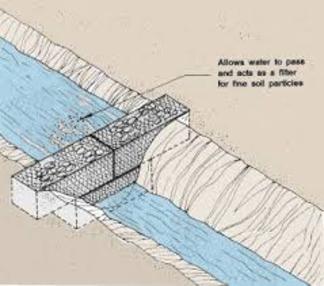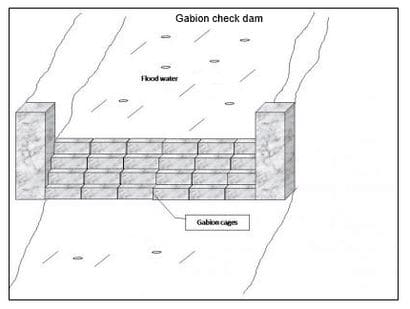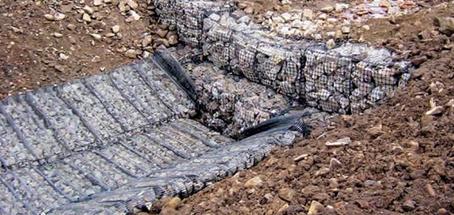GABION ROCK CHECK DAMS

What Is the Purpose of a Check Dam?
Check dams are an effective tool in controlling water flow, preventing erosion and maintaining water levels. Constructed of rock, stone or sometimes gravel, they help regulate water levels and velocities. These are placed either upstream or on channels to increase water retention for limited drainage.
Check dams may be either permanent or temporary installations, with activities depending on their use. The stones are laid in layers across the ditch, with the heights of the check dam increasing as more layers increase. For additional protection, an erosion control blanket may act as an extra layer to strengthen the check dam's capacity for preventing water and soil loss.
The check dam may stabilize the adjacent hill slopes from runoff and erosion. Other erosion prevention practices can include the use of erosion control products or the creation of permanent ditches. With a wide range of erosion control applications, check dams offer a practical and reliable solution.
Types of Check Dams
Check dams come in various types, each designed to address specific needs and conditions. Below are some common types of check dams:
Rock
These check dams are made by utilizing gabion cages and or fabrics to container smaller size stone or standalone large riprap stone. Rock check dams generally consists of well-graded stones with a mixture of rock sizes. Make sure to match the aggregate and riprap sizing and volume to withstand the expected ditch channel flows.
Rock check dams are low-cost and easy to install, replace and move. Erosion control rock check dams are a great solution for areas where concentrated flows cause erosion. They can also slow and divert the velocity of small flows.
Earth
Earth check dams are made with clay soils that have low permeability. This check dam type has a greater potential to erode than check dams made from rock, concrete or wood. Proper care and regular maintenance should be taken to fully stabilize it during and after construction.
In sediment-laden rivers, earth check dams can quickly fill with sediment, reducing their effectiveness and requiring frequent desilting. This can be particularly problematic in areas with high sedimentation rates.
Wood
Wood check dams use natural or pressure-treated wood. The construction materials are typically 6-12 inches in diameter and are sometimes notched to keep flow concentrated in the channel's center to achieve the required drawdown time.
On the downside, wood has limited load-bearing capacity. As such, wooden check dams may not provide sufficient erosion control or sediment retention in areas with heavy sediment loads or high flow velocities.
Concrete
The most expensive option would be concrete check dams for extremely high-flow velocities that may compromise the dam's structural integrity. These check dams minimize potential contamination in the surrounding soils by providing an impermeable solution.
Concrete is rigid and lacks the flexibility of other materials. Concrete check dams may be susceptible to cracking or structural failure in areas prone to seismic activity or ground movement.
Why a Project May Need Gabion To Check Dams
If your project needs gabions for check dams, you've come to the right place. We offer a wide range of products to help protect your environment from the harmful effects of runoff water. Our gabion baskets and AquaRockBags provide excellent channel banks, channel linings and grass-lined channels to reduce the water velocities and create permanent ditches or installations. We understand that in some cases, check dam installations and consolidation check dams are necessary, especially on hilly slopes and adjacent hill slopes. We can provide rock or stone check dams to fit your project and budget needs. You can trust Gabion Supply for all your erosion control products when protecting the environment and controlling runoff water.
What Is the Lifespan of a Gabion in a Check Dam?
We take pride in delivering long-lasting and sturdy products. Our gabions will potentially last decades, even when facing adverse conditions.
Check Dam Maintenance
Keeping up with maintenance is key to maintaining the strength of these gabion walls. We highly recommend checking and resetting the stones often and adjusting any weakened wire mats. This maintenance helps to reduce erosion and ensures a more even spread of pressure on the stones.
Here are some basic steps you can follow:
- Remove sediment.
- Adjust rock arrangements.
- Troubleshoot problem areas.
- Repair structural damages promptly.
- Explore permanent solutions, such as installing gabion baskets or concrete structures.
By following these guidelines, you can ensure the long-term effectiveness of your check dam. Whether you're building a short-term or a long-term dam, we're confident that our walls will offer years of strength and protection.
How Does a Gabion Check Dam Prevent Erosion?
Gabion check dams are highly effective in preventing soil erosion. They are placed strategically on riverbanks, shorelines and streams and act as a physical barrier. This helps reduce water flow, prevents waves and debris from impacting the soil and slows down the erosion process. The cages are filled with rock or other materials to give them extra stability, and because they are easy to install, they are also a cost-effective solution.
In addition to reducing soil erosion, gabion check dams store water, reduce peak flood flows and reduce downstream erosion. The dams also provide aquatic habitat, help restore riverbanks, provide pool habitat and sediment storage, and can also help with fisheries restoration projects. As the water flows over the gabions, sediment is captured and deposited along the upstream side of the structure.
Gabion check dams control soil erosion to protect the environment and the surrounding community. The structure can impact erosion, flood control and other ecosystem considerations. It is essential to contact a professional to discuss the best options for your location, as the design and materials used can impact the performance and cost of the project.
When Should Gabion Check Dams Not Be Used or Considered?
When considering a check dam solution, gabion check dams may not be the best solution in all scenarios. In situations where environmental impacts are crucial, gabion check dams may not be a great option due to their significant land alteration. Their stonework aesthetic may not always be suitable, depending on the surrounding environment or region.
In very active and constantly eroding stream systems, gabion check dams may require frequent maintenance to repair the gabion walls due to the force of the current and the continuous sediment deposits. These situations may be more suitable to AquaRockBags due to their shape and easy placement and repositioning. Furthermore, in areas prone to high sediment flows, sandbags, matting, or silt curtains may be needed in addition for additional protection. For more permanent installations, it is crucial to consider whether or not gabion check dams will hold up to the magnitude and power of the particular environment.
When To Consider Gabion Check Dams
Gabion check dams are a great choice when protecting against flooding, soil erosion, and stormwater runoff. We have seen gabion check dams provide significant, reliable benefits to water conservation in all types of environments. Gabion check dams are an effective and low-maintenance option. Whether it's a waterway or just a section of your backyard, consider gabion check dams as a great way to improve the quality of the environment.













